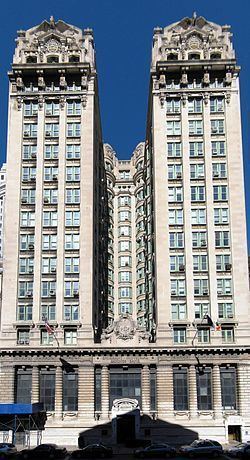Built 1909-1912 Designated NYCL July 9, 1985 Architectural style Beaux-Arts architecture Architect Raymond F. Almirall | NRHP Reference # 82003375 Opened 1912 Added to NRHP 25 February 1982 | |
 | ||
Location 51 Chambers St.,
Manhattan, New York City Similar A T Stewart Company, Surrogate's Court, Broadway–Chambers Building, Bowery Savings Bank, Former New York Life Insur | ||
The Emigrant Industrial Savings Bank building at 51 Chambers Street between Broadway and Centre Street in the Civic Center neighborhood of Manhattan, New York City, was built in 1909-1912 and was designed by Raymond F. Almirall in the Beaux-Arts style. At the time the 17-story structure was the largest bank building in the United States, and was the first skyscraper to use the "H" lay-out, which provided light and air to more parts of the building.
The bank itself had been organized in 1850 by Roman Catholic Archbishop John Hughes and the Irish Emigrant Society, with the purpose of protecting the savings of Irish immigrants newly arrived in the city. The current building is the third built by the bank on the same site.
The building is now owned by the City of New York. It was added to the National Register of Historic Places in 1982 and both the exterior and the first floor interior were designated New York City landmarks in 1985.
Architecture
The Emigrant Industrial Savings Bank runs through the block between Reade and Chambers Street (measuring 123 feet on Chambers and 125 on Reade). Its first few floors form a base from which the floorplan towers rise. This base is composed of a series of double-height rusticated piers and engaged columns, forming nine bays, resting on a basement story and supporting an entablature. The double height windows of these nine bays light the two-story banking hall within. Panels at their base are adorned with large, high-relief swags; at the top of each bay is a stylized keystone with large guttae; palm frond reliefs adorn it on either side.
There are three entrances, a single-story one at either end set in the basement story, and a double-story central entrance rising into the upper portion of the base. The two smaller entrances have plain granite surrounds, with a small amount of stylized ornament and the Bank's street address at the top. The central entrance, besides a similar plain granite surround, is topped by a segmental pediment enclosing cornucopias and the word "Entrance"; from it, carved wreaths descend on either side of the entrance surrounds. This central entrance has heavy bronze doors, with new protective glass doors recently placed in front of them. In the narrow window bays on either side of the central entrance bay are original bronze torcheres. The central entrance bay is further demarcated by a large stepped pediment; seated on either side is a large sculpted hunan figure, male on the west and female on the east, each surrounded by sculpted swags. In the center is an enormous coat-of-arms, with the figures of a colonist and an Indian, and the shield of New Amsterdam in between, topped by an eagle. Above the large base, the building rises in an "H-shaped" plan which allows light and air to reach all the office spaces within the tower. From the street there is an impression of twin towers which are capped visually by an ornamental treatment on the top and attic floors.
The Bank is no longer used by the company for which it was built. It has joined the ranks of many distinguished buildings surrounding City Hall Park which are now used for municipal offices. It retains, nevertheless, its historical significance as a beneficient institution for the enormous immigrant population of 19th and 20th century New York. As a distinguished Beaux-Arts design applied to the American innovation of the skyscraper, and an ingenious pioneering solution to the problem of bringing light to office users,the Emigrant Industrial Savings Bank stands as an important landmark in the development of 20th century New York architecture.
